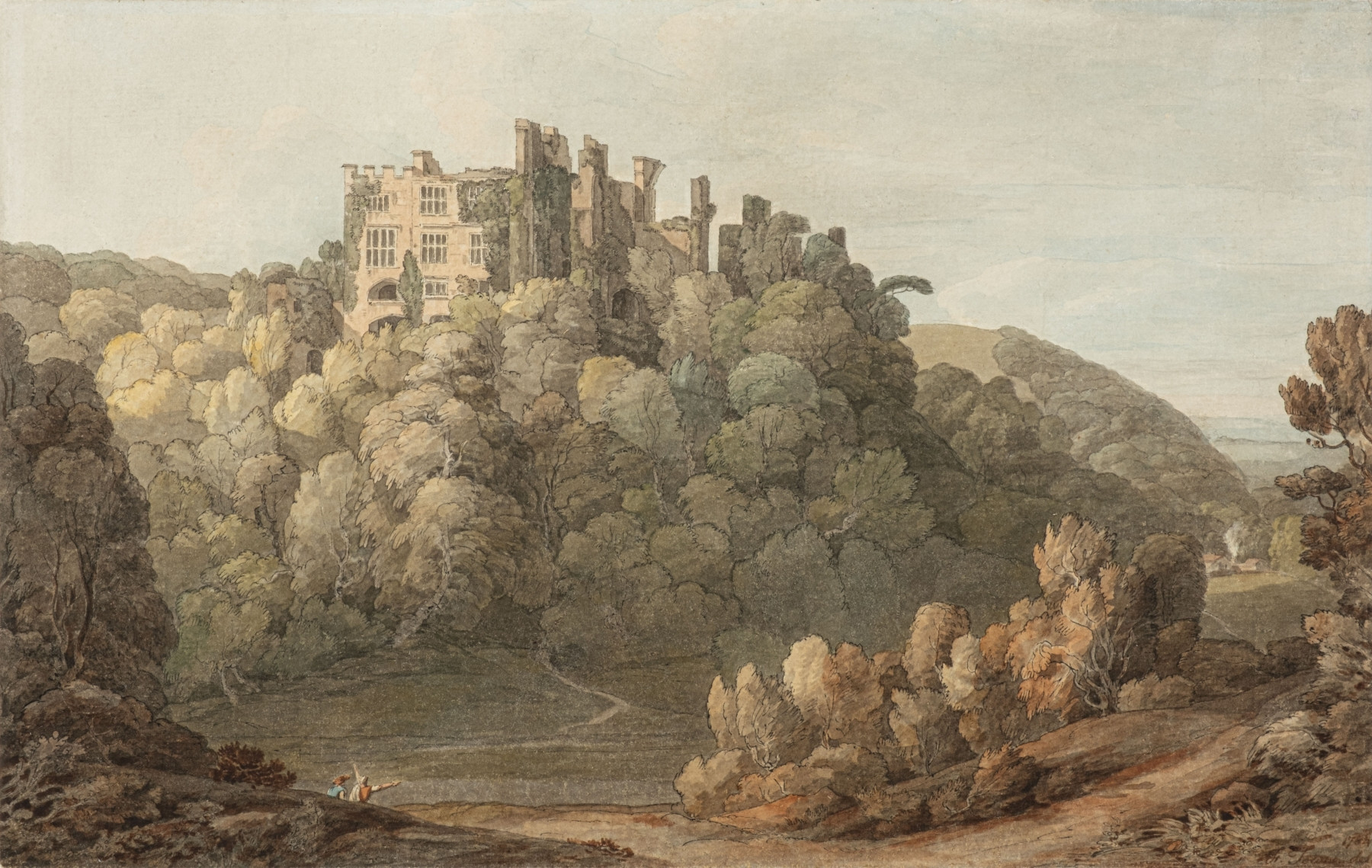
(click image to enlarge)
In the late eighteenth century, Berry Pomeroy Castle had all the characteristics of a romantic ruin. Set in a remote location overlooking a stream running into the Dart above Totnes in South Devon, it nonetheless attracted visitors from far and wide.
Francis Towne was established in Exeter as a landscape painter from the late 1760s. Before long, he was busily employed on many of the great estates of the county, painting views of the houses and parks, many of which were being extended, renovated or redesigned in the latest fashion. Berry Pomeroy, abandoned and stripped of its roof, stood as a reminder of the fickleness of fortune. The late mediaeval castle had been bought by Thomas Seymour, brother of Henry VIII’s third wife, Jane Seymour, around 1547. He proceeded to erect a new wing in the Continental Style, with large windows offering views of Dartmoor from the upper floors. Thomas was executed in 1552, accused of plotting against the young king, Edward VI, his nephew. The building, probably unfinished, was certainly habitable, and the family remained there until 1700.
Towne made three drawings of the castle, perhaps returning there more than once, as each is markedly different in approach. The one thing they have in common is the atmosphere of dereliction. In what is probably the earliest, dated 1775, the repeated geometry of the windows frames nothing but sky (Royal Albert Memorial Museum and Art Gallery, Exeter). There is a larger, more grandiose view of the old mediaeval gatehouse, with the remaining masonry half smothered in ivy (Metropolitan Museum of Art, New York). Finally, this newly discovered watercolour of the house seen from the valley, as if under siege from the surrounding hordes of trees.
In 1805, Towne mounted a one-man exhibition of nearly 200 of his watercolours, virtually his life’s work. Among the first group was one of the views of Berry Pomeroy. 1805 was the year of the first exhibition of the Society of Painters in Watercolours, who were shortly to take over the very gallery where Towne was exhibiting. It seems he wanted to show off his own achievements in the medium, but he was also wary his crisp, linear style may appear old-fashioned, too eighteenth-century. So he repainted many of the watercolours, in the process carefully scratching out the dates inscribed both on the drawings themselves and on the back of their stiff mounts.
The date on this view of Berry Pomeroy from the valley seems to have originally read ‘1784’, but the top of the third numeral is now illegible. By then, Towne had returned from his trip to Rome in 1780-81. He had a different feeling for ruins, and now accentuates the isolated piers of masonry far more dramatically. The loose brushstrokes shading the foliage, in a restricted palette ranging from pale buff to bluish-grey, have a subtlety which can also be found in other work from this period. The sharp tan of the foreground bushes, however, most likely belongs to the 1805 repaint. It creates a greater sense of depth, but otherwise rather obstructs Towne’s carefully devised movement across the space, marked by the outstretched arm of the foreground figure, gesturing towards the smoke issuing from Castle Mill Farm further down the valley. It is as if he does not even notice the castle, making it appear all the more isolated as a result.
This view is roughly the same size as the one of the courtyard dated 1775. It is possible they could both have been drawn around the same time, but not necessarily coloured immediately. The single watercolour Towne decided to show in public in 1805 is most likely the larger one of the gatehouse, altogether more impressive and more richly coloured. In his on-line catalogue, Richard Stephens discounted this idea, since Towne noted on the back he had reworked it later in the year. Yet, once started, Towne’s habit of revisiting and retouching became hard to break. Fortunately for posterity, here, Towne left the central bank of trees as originally conceived, a testament to his feeling for wild nature which his 1786 trip to the Lake District was shortly to confirm.
Timothy Wilcox